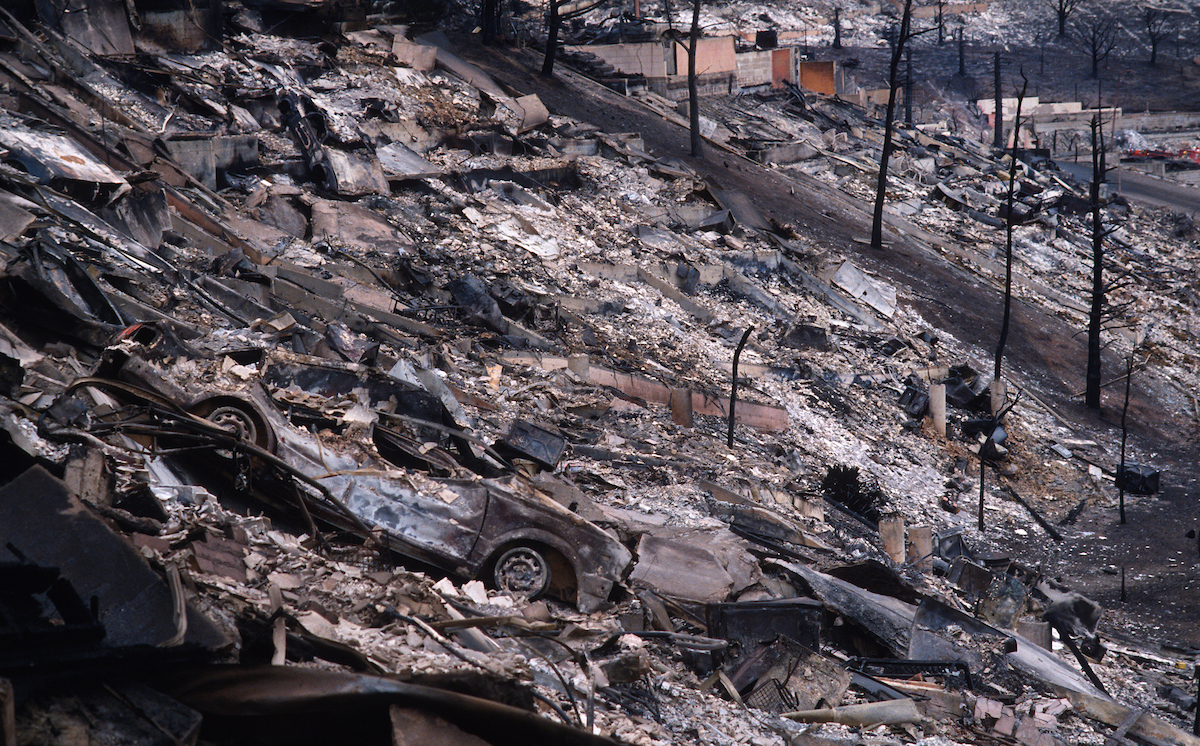1991 East Bay Hills fire, also known as "Tunnel Fire." 
After the first heavy rains of 2018 caused flooding and debris flows in Southern California, destroying nearly 100 homes, closing major highways and killing 20 people, officials continue to be concerned about how more rains will impact communities in and near burn scars across the state.
Prolonged dry spells can offer false impressions that there is no flood risk. However, once the ground is burned, it is changed, causing the water flow to be dramatic. People should stay away from burned slopes, storm channels, and natural drainages. Those interested in flood insurance should talk to a professional to find out more.
Rates of erosion and runoff can increase to dangerous levels following wildfires in California. Wildfires dramatically change the landscape and ground conditions, which can lead to the increased risk of flooding even with light rains. Natural, unburned vegetation and soil normally act as a sponge during a rainfall event. However, wildfires create physical changes in the landscape. The heat from a fire can bake the ground, creating a surface that will not absorb water, thereby increasing the speed with which water flows off the slope. When these normal and protective functions are compromised or eliminated by a severe wildfire the potential for significant erosion, flooding, and debris flows is magnified.
While crews spend time during and after a wildfire identifying and repairing areas of concern before winter storms, it is important for the public to know that methods of flood, debris flow, and erosion prevention are no guarantee. Flash floods occur most often when rainfall reaches half an inch in an hour in a burned area. Other factors that can increase flooding and debris flows are how severe the fire was, how steep the terrain is, how much time the ground has had to heal itself, and the amount of post-fire vegetation recovery.
Department of Water Resources Director Karla Nemeth said, “Thousands of California residents have endured the horror of wildfires that destroyed their homes, and now many others are suffering from flooding over those same landscapes. We urge everyone living and working near the fire zones to carefully assess the threat of post-fire flooding.”
Cal OES Director Mark Ghilarducci called for vigilance in the post-fire environment: “Last year’s devastating wildfires and record-breaking storms remind us of the natural disasters California faces. I encourage all Californians to look at their risks and take steps to be prepared for the next disaster.”
“This past fire season has been very deadly and damaging and now the public must prepare for flooding and erosion,” said Chief Ken Pimlott, director of CAL FIRE. “CAL FIRE and many other agencies have been working in burn areas during and after a wildfire to address these issues to help protect communities, but it is imperative that residents stay aware of their surroundings and heed all warnings and orders from emergency officials.”
Roy Wright, Deputy Associate Administrator, Federal Insurance and Mitigation Administration, said: “FEMA urges Californians to seriously consider the purchase of flood insurance as the best financial protection against the increased threat of flooding created by the recent wildfires.”
Dianna Crilley, USGS’s Associate Director for Data, USGS California Water Science Center, advised Californians to use tools available online. “Early warnings issued by the National Weather Service based on computer models, rainfall forecasts, and USGS real-time streamflow data can help emergency managers and residents be informed and prepared for potentially dangerous post-fire conditions.”
Many federal, state, and local emergency agencies are partnering up to alert the public about steps to take to prepare yourself and your family ahead of winter storms. Listen to trusted information sources and sign up for emergency alerts to ensure that if emergency strikes, you are notified as soon as possible. Monitor incoming storms, especially if you live in burned areas or downslope of a burned area and heed all warnings and orders from emergency officials. Lastly, have an evacuation plan in place and make sure all family members are familiar with it.
###
MEDIA NOTES:
